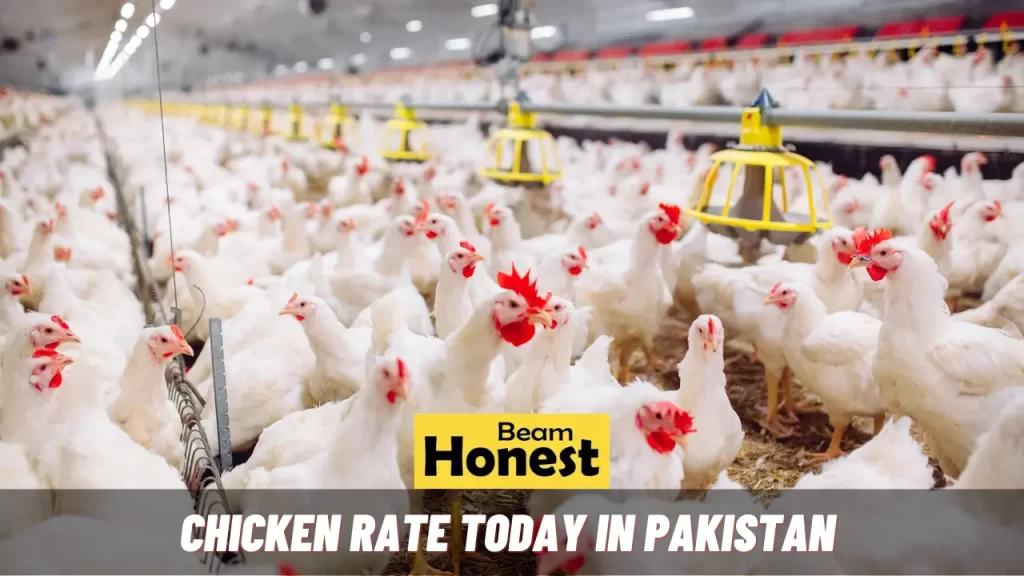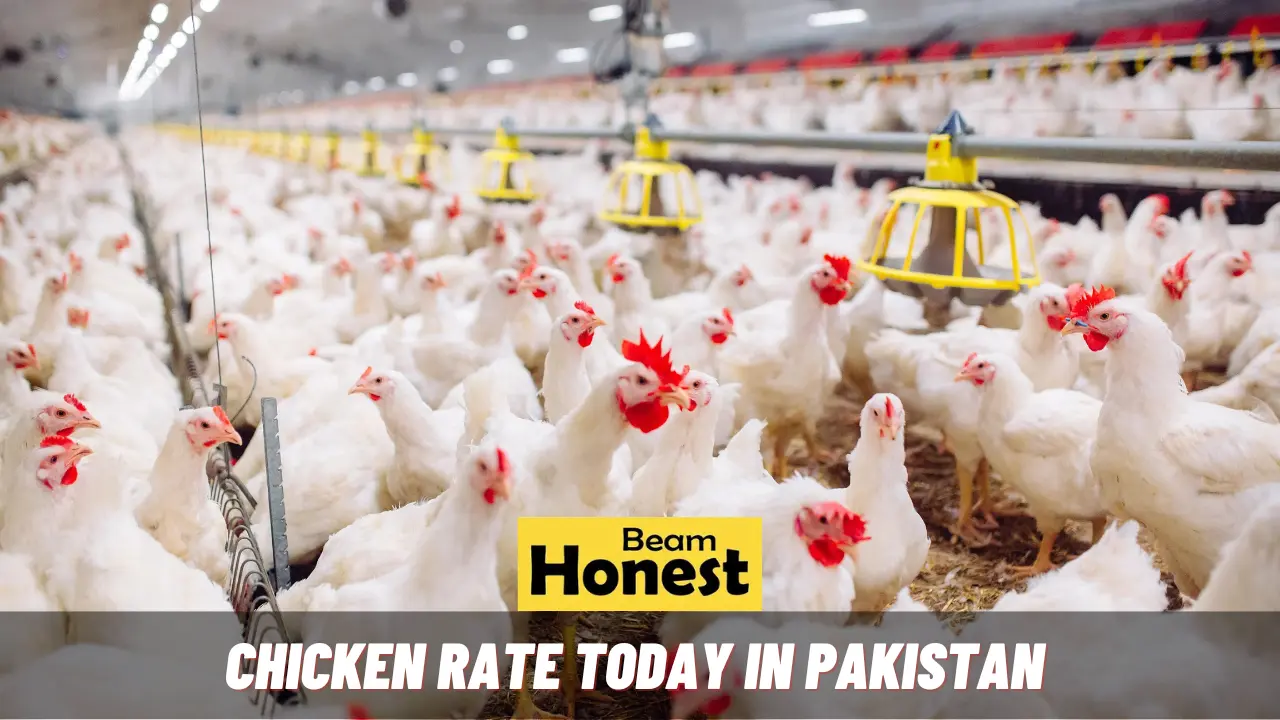In the bustling landscape of Pakistan’s economy, where prices of commodities seem to dance to an ever-changing tune, one item that holds a significant place on every household’s shopping list is chicken. The chicken rate stands at Rs. 562 per kg across the country. The daily cost of living in Pakistan is subject to a constant ebb and flow, as prices of essential commodities experience fluctuations.
Among these staples, chicken stands out as a versatile protein source that finds its way into countless households’ kitchens. Understanding the current chicken price is not only important for budget-conscious consumers but also for those engaged in the poultry and food industry.

Chicken Rate in Different Cities of Pakistan Today
The cost of chicken can vary significantly across different cities in Pakistan. Factors such as supply, demand, and local market conditions contribute to these variations. Consumers and businesses need to stay informed about the current chicken rates in their respective cities to make informed decisions regarding purchases and investments.
Chicken Price in Rawalpindi
Rawalpindi, another key city, exhibits an intriguing price range for chicken prices, which highlights local supply and demand dynamics. Consumers can purchase packed chicken within the price range of Rs. 750 to 885 per kg, while chicken meat prices usually range between Rs. 545 and 585 per kg. These discrepancies could be related to regional factors, consumer behaviors, or local market conditions.
| Chicken Per KG | Minimum Rate | Maximum Rate |
|---|---|---|
| Packed Chicken | Rs. 750 | Rs. 885 |
| Chicken Meat | Rs. 545 | Rs. 585 |
Also Read:
Chicken Rate Today in Multan
Moving further south to Multan, chicken rates reflect closely those found nationwide. One kilogram of live chicken can be had for Rs. 410 while retail markets in this city offer pre-packed poultry for sale at Rs.550 per kg. But pre-packaged versions cost more due to the preparation processes required before delivery! Opting for convenience comes at a cost pre-packaged options of Rs. 750 per kg entail added preparation expenses, yet offer a more economical choice.
| Chicken | Price |
|---|---|
| Alive Chicken | Rs. 410 |
| Chicken Per KG | Rs. 550 |
| Packed Chicken Per KG | Rs. 750 |
Chicken Rate Today in Islamabad
Today’s Chicken Rate Within the heart of Pakistan lies Islamabad where prices vary depending on form and location. Alive chicken costs Rs. 410 per kg at live markets while retail markets see modest price increments, eventually reaching Rs.550 per kg for retail chicken purchases. Pre-cut options, which require additional effort and processing to provide these convenience options are priced higher at Rs 603 per kg due to this extra effort being involved with creating such packages.
| Chicken | Price |
|---|---|
| Alive Chicken | Rs. 410 |
| Retail Market Per KG | Rs. 550 |
| Packed Chicken Per KG | Rs. 603 |
Today Chicken Rate in Karachi
In Karachi, Pakistan’s economic center, the price of chicken closely mirrors that of its national average. Live poultry costs Rs. 410 per kg while retail market pricing can go as low as Rs. 450. Consumers interested in pre-cut options pay an extra amount, usually set at around Rs. 575 per kg. Showing how different distribution networks and consumer preferences play an impactful role here.
| Chicken Per KG | Price |
|---|---|
| Alive Chicken | Rs. 410 |
| Chicken Meat | Rs. 450 |
| Packed Meat of Chicken | Rs. 575 |
Chicken Meat Price Today in Lahore
Lahore prices show wide variations due to various market forces, with live chicken prices fluctuating between Rs. 600 and 650 per kg for live birds; chicken meat prices show more stability with prices typically falling within Rs. 750-850 range per kg. However, factors such as demand-supply dynamics, transportation costs, or evolving local market trends could explain these variations.
| Chicken | Minimum Rate | Maximum Rate |
|---|---|---|
| Alive Chicken | Rs. 600 | Rs. 650 |
| Chicken Meat Per KG | Rs. 750 | Rs. 850 |
Different Poultry Item Rates
Pakistan’s food industry benefits greatly from poultry items beyond whole chicken and pre-cut meat. Prices fluctuate depending on demand, supply, and market trends with items like eggs, chicken feet, and offal being priced according to demand, supply, or both. However, monitoring their rates provides valuable insight into how the poultry sector functions as an overall entity.
| Poultry Item | Rates |
|---|---|
| Chicken Nick Per KG | Rs. 90 |
| Chicken Wings Per KG | Rs. 260 |
| Chicken Mince Per KG | Rs. 700 |
| Chicken Drumsticks Per KG | Rs. 470 |
| Chicken Leg With Skin Per KG | Rs. 335 |
| Chicken Breast Boneless Per KG | Rs. 750 |
| Chicken Without Skin | Rs. 445 |
| Desi Chicken Meat Per KG | Rs. 1150 |
| Chicken Leg Per KG | Rs. 450 |
Factors That Affect Chicken Prices
Like other commodities, chicken prices can be affected by numerous external influences. These may include:
- Feed Costs: Feed costs play an instrumental part in the overall pricing of poultry products.
- Supply and Demand: The supply and demand fluctuations at local and national levels can impact prices in unpredictable ways.
- Transportation Costs: Rising fuel costs can add an unexpected layer of expense.
- Market Competition: Rivalry within the poultry industry can radically shift pricing strategies.
- Government Regulations and Policies: Changes in regulations can wreak havoc with production costs and prices, impacting production costs as a whole and, therefore, prices.
Also Read:
Ehsaas Rashan Program Online Check
Overall Conclusion
The chicken cost in Pakistan is a reflection of the intricate interplay between supply, demand, production costs, and market forces. While the current rate stands at Rs. 510 per kg, it’s essential to recognize that this figure is part of a broader narrative that encompasses diverse cities, consumer preferences, and economic dynamics. As consumers make their choices at local markets and supermarkets, they are participating in an ecosystem where every purchase has a ripple effect.
Frequently Asked Questions (FAQs)
Chicken rates are subject to change due to various factors such as market conditions, feed costs, and demand fluctuations. While some stability might be expected, it’s essential to stay updated on the latest market trends.
Chicken meat prices can be influenced by processing costs, packaging, and market segmentation. Different cuts of meat can also have varying perceived values, affecting their pricing.
Keeping an eye on local markets, supermarkets, and online resources can help consumers stay informed about the latest chicken rates in their area.
The government can implement policies that address feed costs, support local poultry farming, and ensure transparent pricing mechanisms to promote stability in chicken prices.
Factors like global grain prices, currency fluctuations, and international trade agreements can indirectly influence local chicken rates by affecting production costs and feed expenses.

